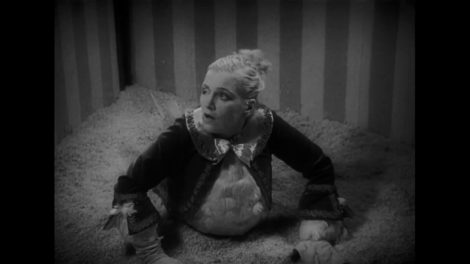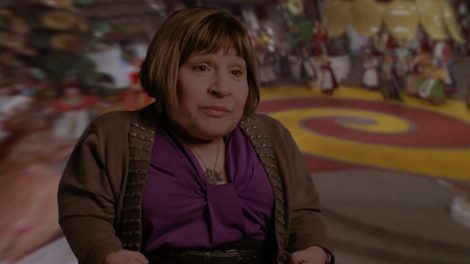Code of the Freaks
Front Row at the Movies by Shirrel Rhoades
[mr_rating_result]In 1932, director Tod Browning was hired to make a movie based on a short story called “Spurs.” It was told of “a love triangle among a wealthy dwarf, a gold-digging aerialist, and a strongman; a murder plot; and the vengeance dealt out by the dwarf and his fellow circus freaks.” Yes, a horror film.
Browning had the right qualifications because the previous year he had directed “Dracula,” the horror film based on the Bram Stoker’s classic vampire tale.
 Even though this was a pre-Code no-rules film, the studio nonetheless was shocked by Browning’s casting – using real-life sideshow freaks. MGM’s bigwigs demanded that the film be tamed down, cutting many scenes and adding new footage to pad out the story. Even so, theater audiences of the time found “Freaks” to be grotesque. This box office failure was banned in the United Kingdom for over 30 years, and was labelled as “brutal and grotesque” in Canada.
Even though this was a pre-Code no-rules film, the studio nonetheless was shocked by Browning’s casting – using real-life sideshow freaks. MGM’s bigwigs demanded that the film be tamed down, cutting many scenes and adding new footage to pad out the story. Even so, theater audiences of the time found “Freaks” to be grotesque. This box office failure was banned in the United Kingdom for over 30 years, and was labelled as “brutal and grotesque” in Canada.
However, during the more-permissive ‘60s, “Freaks got a reappraisal. Critic Andrew Sarris declared it one of the “most compassionate” films ever made. It was screened at the 1961 Venice Film Festival. Historians saw it as a metaphor for class conflict. Studied by scholars for its portrayal of people with disabilities, it was deemed to have an “anti-eugenics message.”
All this bruhaha stemmed from the film’s stars. No, I don’t mean Wallace Ford and Leila Hyams and Olga Baclanova. I’m referring to an array of human oddities that included the famous Siamese twins (read: conjoined) Daisy and Violet Hilton; Schlitze Surtees, a man born with a neurodevelopmental disorder that gave him an undersized brain and skull; Johnny Eck, missing the lower half of his body; an armless girl named Frances O’Connor; Peter Robinson, known as the Human Skeleton; bearded lady Olga Roderick; Elvira and Jenny Lee snow, human pinheads; Koo Koo the Bird Girl; and Prince Randian, an armless and legless man known as the Human Caterpillar and relegated to crawling like a worm.
Today, we might expect to see people with some of these disabilities in a Shriners Hospital ad on TV. But back in the ‘30s they were relegated to traveling carnivals and so-called freakshows.
As an entry in its annual presentation of the Southern Circuit Tour of Independent Filmmakers, Tropic Cinema will be screening a documentary titled “Code of the Freaks” from February 21-24. A combination of virtual cinema with an in-person visit from director/producer Salome Chasnoff, the Southern Circuit series is funded by local film buffs Michael and Linda Mewshaw.

“Code of the Freaks” takes its name from the Tod Browning film. Thanks to a trio of insightful writers – Susan Nussbaum, Alyson Patsavas, and Carrie Sandahl – it focuses on the roles of disabled characters in film. Drawing from movie clips spanning the past 100 years, “Code of the Freaks” examines how movie imagery has shaped our view of disabled people.
Among the stereotypes examined are “the miracle cure, the blind guy driving a car, the magical little people, the face-feelers, the sexless, the better off dead.” The theme surveys deaf characters, blind characters, blindness as a superpower, the kill or cure option, and the “happy ending” to a story of a character with a disability, race and sex.
One viewer commented, “Hollywood must not rely on the same old stories of relying on disabled people as inspirational or cliched-stereotypes of characters who are villainous or victimized or pitied. But, one day that there will be a film with actual disabled people that are not inspirational, but living their daily lives in a humorous or ironic way that makes fun of the formula.”
My entry into the best movies about disabilities ever made would be “The Best Years of Our Lives,” the Academy Award-winning film is about three US servicemen re-adjusting to civilian life after coming home from World war II. One of the winners of its seven Oscars was Harold Russell, a veteran who had hooks instead of hands as the result of a bomb blast. Admittedly, it was inspiration, a better outcome than Russell faced in real life. He sold his Oscar at Auction.
You will glimpse Russell along with many others in this parade of impaired movie characters.
Documentarian Salome Chasnoff (“Brink of Survival,” “Turning a Corner”) says, “Movies have the power to shape the beliefs and behaviors of non-disabled people toward people with disabilities, and of disabled people toward themselves. Movies build astonishing fictional worlds where they hold us captive on two-hour journeys, worming their way into our psyches. They shape our expectations in ways we’re not always aware of – especially in cases where the films provide our only references for unfamiliar experiences. We love movies and it’s a powerful love that can be mesmerizing. But the consequences can be toxic.”
As the Tropic reopens with caution, please familiarize yourself with the protective house rules and procedures. In particular, please note that all tickets must be purchased online. Got questions? Email info@tropiccinema.com.
Email Shirrel: srhoades@aol.com


Ratings & Comments
[mr_rating_form]